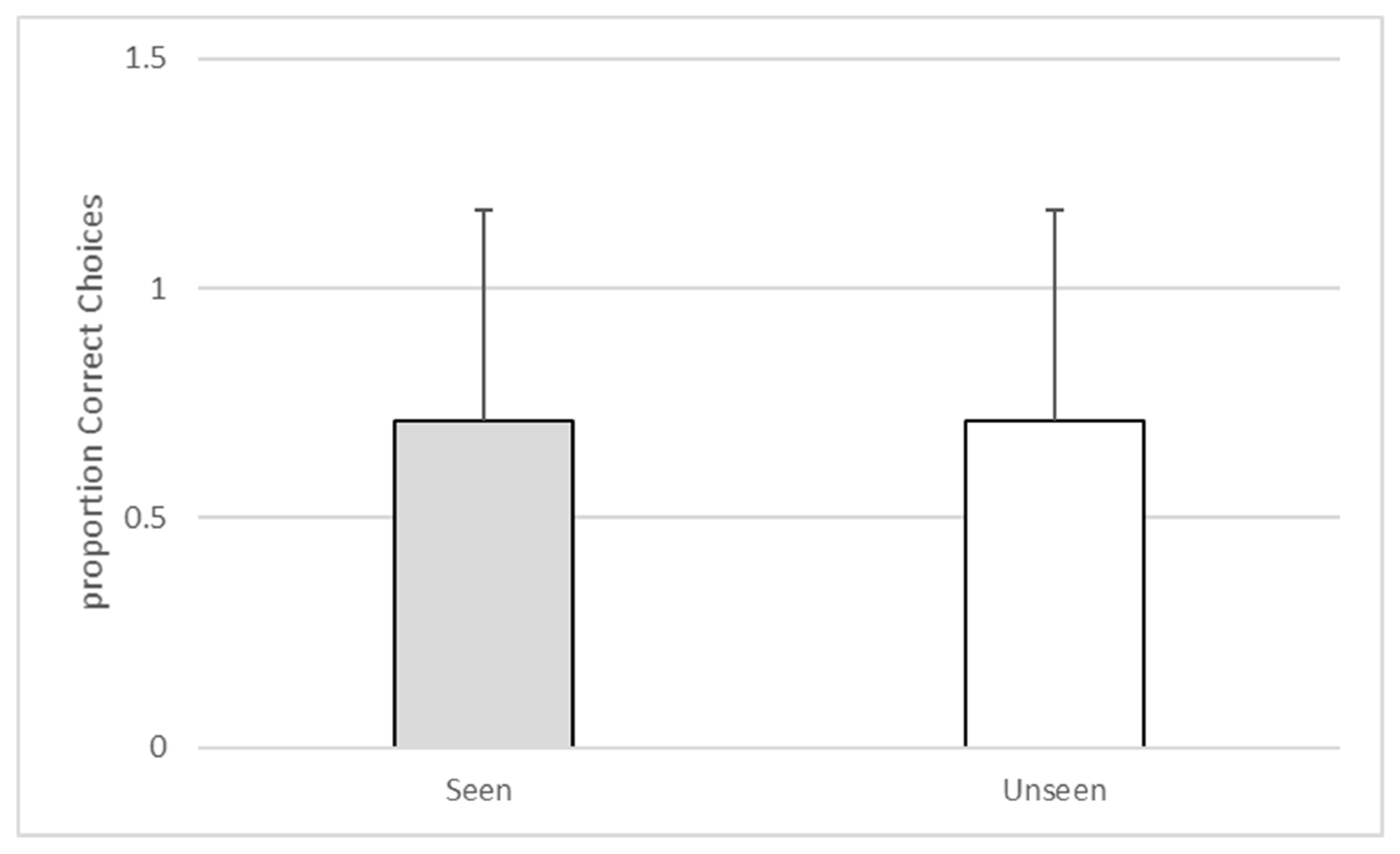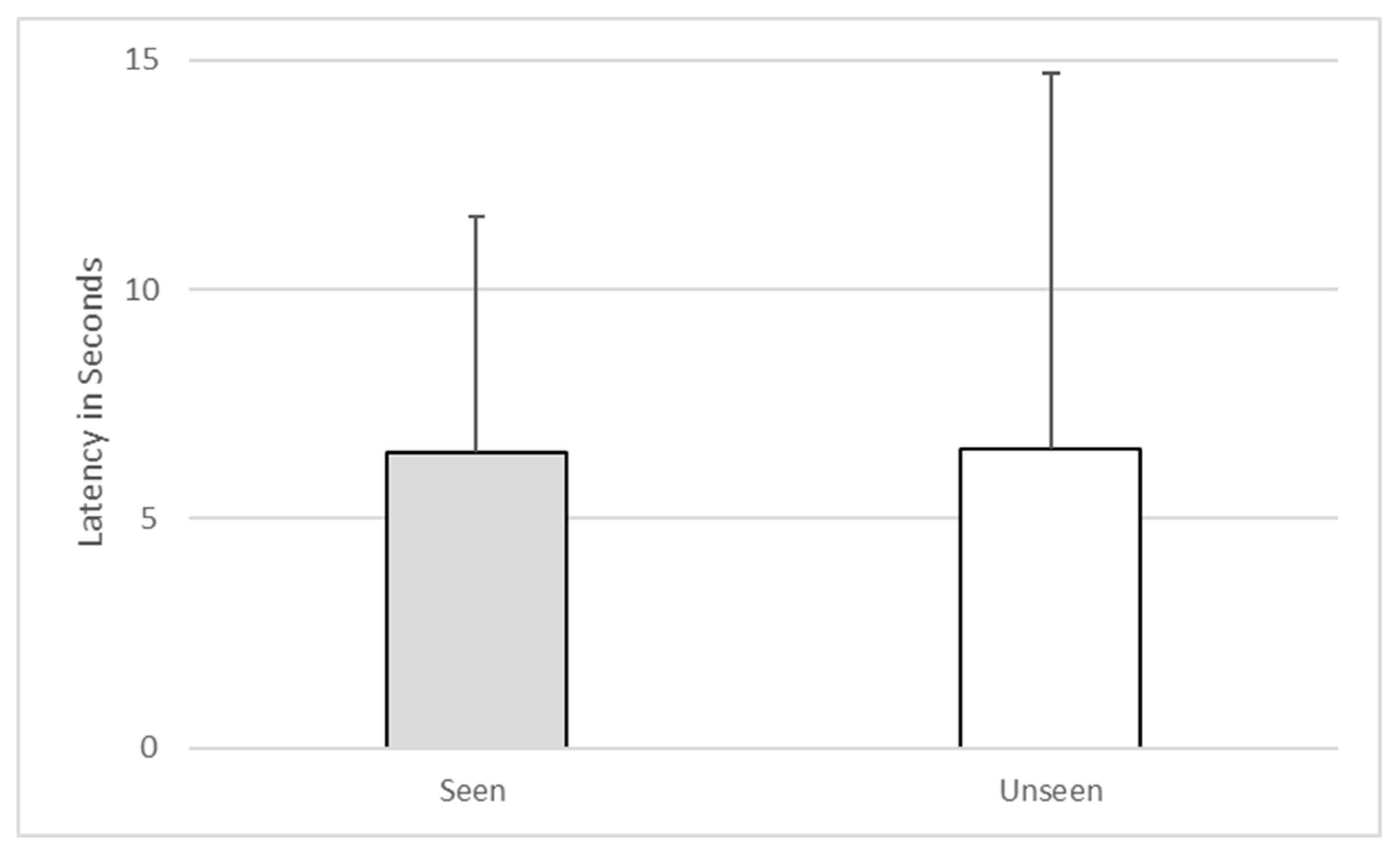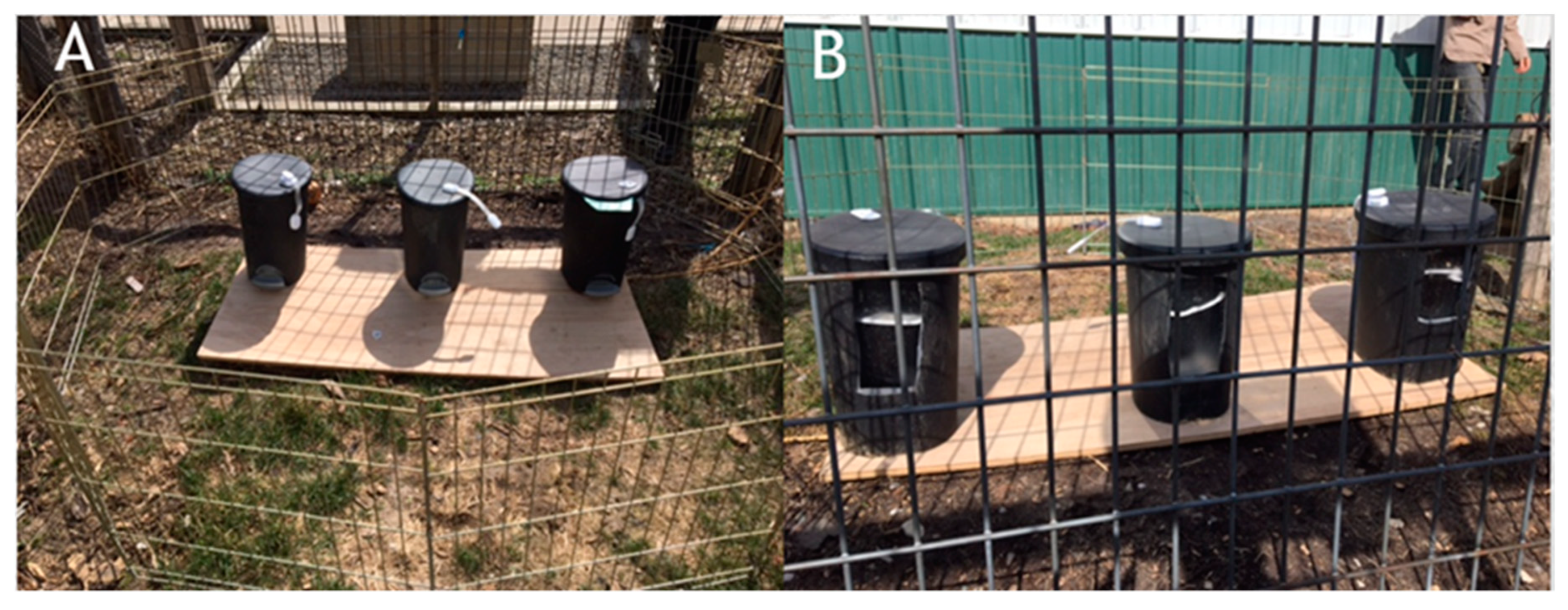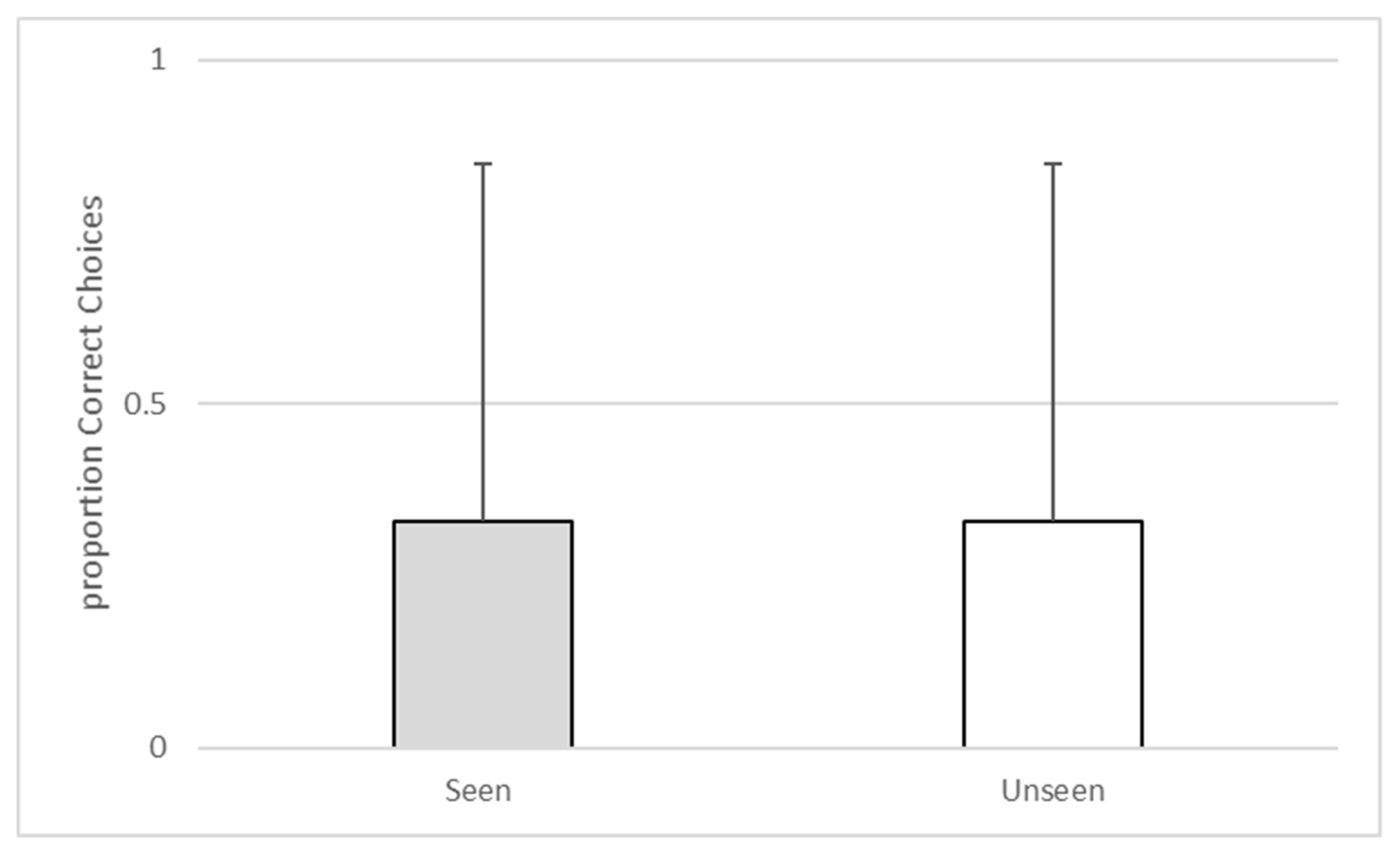1. Introduction
Metacognition, or knowing what one knows, involves two distinct processes: monitoring and control [
1]. Monitoring refers to making judgements about one’s memory and/or cognition, whereas control involves using metacognitive judgements to guide one’s behavior [
2]. For example, when studying for an exam, students make judgements about how much they have learned by assessing their current state of knowledge (monitoring). These judgements are used to stop studying when students feel they have adequately learned the material (control). Metacognition was once thought to be unique to humans [
2]. However, evidence in the last few decades suggests that some nonhumans may possess metacognitive abilities (e.g., dolphins [
3], rats [
4], rhesus macaques [
5], chimpanzees and orangutans [
6], and western scrub jays, [
7]; see reviews in [
8,
9]). Given that arctic foxes bury their food for future need (i.e., caching), which involves remembering the location of cached food, they are good candidates for metacognitive abilities. However, no fox species have been tested to our knowledge. Here, we develop two procedures appropriate for testing information seeking in an arctic fox for the first time.
Initial studies addressed the ability to monitor knowledge by testing uncertainty monitoring (the capacity of a person or animal to recognize when they are lacking confidence about a relevant piece of information; [
3,
10,
11]). Many uncertainty monitoring tasks use choice discriminations, such as distinguishing long tones from short tones, of varying discriminability. Subjects are then given an opportunity to emit an uncertain response, (e.g., selecting a specific button or lever) that allows them to opt out of trials and still receive a reward, albeit usually a smaller or less preferred reward than they would receive on correct trials [
3]. The rationale for these studies is that an animal with metacognitive access (i.e., knowing when memory is likely to fail or performance is likely to be inaccurate) should opt out of more difficult trials, given that the ability to judge accurately and gain a reward is lower [
12].
Smith and colleagues [
3] were among the first to use such a paradigm. They trained a dolphin (
Tursiops truncatus) to discriminate between tones ranging from 1200 to 2100 Hz by approaching the correct paddle based on its spatial location. For a 2100 Hz “high trial”, the left paddle was correct. For a “low trial” of 1200 to 2099 Hz, the right paddle was correct. When the dolphin chose the correct paddle, a food reward was given. The dolphin was also presented with a third “opt-out” paddle placed in between the left and right paddles. If the middle paddle was depressed, the ongoing trial was discontinued and replaced with a low trial that the dolphin always got correct. The dolphin’s responses were then compared to human responses on an analogous task. Smith et al. found that the dolphin was more likely to use the third “opt out” paddle when the tone thresholds were indistinct (e.g., 2099 Hz) compared to when the tone thresholds were clearly distinguishable.
They also found that the dolphin’s behavior (e.g., slowed approach to the paddles, wavered among paddles, swam toward the paddles with an open mouth while sweeping his head from side to side, or while opening and closing his mouth rhythmically) when the tone thresholds were indistinct reflected apparent uncertainty. Behavior reflecting apparent uncertainty has also been identified in rhesus macaques (
Macaca mulatta) during similar judgement tasks [
13]. Foote and Crystal [
4] found that, when given the option, lab rats (
Rattus norvegicus) chose to opt out of a noise length discrimination task at higher rates as the difficulty of discrimination increased. Furthermore, Beran and colleagues [
5] found that rhesus macaques declined to make numerosity judgments (more or fewer dots than a center value) on trials in which the number of dots presented on a screen were closer to a center value, and thus, more difficult to discriminate. Thus, many distantly related species have shown some evidence of uncertainty monitoring.
Modified uncertainty paradigms have also been used to test metamemory, or the knowledge of what one does and does not remember [
10]. Kornell, Son, and Terrace [
14] presented rhesus monkeys with six sample pictures on a touch screen. Nine pictures were then shown simultaneously—one of which had been presented among the previous sample pictures. Subjects were required to touch the sample picture and then choose an icon based on how confident they were about their responses. If the high confidence icon was chosen, a correct response to the memory task resulted in a large reward and an incorrect response resulted in no reward. If the low confidence icon was chosen, a small reward was given regardless of whether the response to the memory task was correct or incorrect. Rhesus monkeys chose the high-confidence icon more frequently after correct responses than after errors, and they chose the low-confidence icon more frequently after errors than after correct responses. Similarly, Hampton [
15] had rhesus macaques perform a delayed matching-to-sample task. On some of the trials, the macaques were given an option to opt out of completing the task for a less preferred food reward. Hampton found that the macaques’ matching performance declined with longer delays between sample presentation and presentation of the match, that they declined memory tests at long retention intervals, and that they maintained strong performance levels even at long retention intervals when they were given the opportunity to choose when they would complete the memory test. This evidence suggests that rhesus macaques are able to monitor internal signals of remembering. Tufted capuchin monkeys (
Cebus apellaa) and orangutans (
Pongo pygmaeus) have also been shown to opt out of memory test trials in which they are likely to err [
16,
17]. However, Beran and colleagues [
18] found that capuchin monkeys rarely or never chose to use an uncertainty response when given a psychophysical discrimination task (e.g., density discriminations), and metamemory tests conducted with pigeons (
Columba livid) have produced null results [
10]. Thus, although some components of metacognition appear broadly distributed in the animal kingdom, it is not ubiquitous.
The aforementioned studies suggest that some subjects knew when they did and did not know the correct response to a discrimination task. However, critics of uncertainty paradigms argue that subjects may not recognize their state of uncertainty but, instead, may learn to use the escape response in the presence of certain stimuli [
19]. Subjects may form associations between observable cues and outcomes such as learning to avoid tests that include stimuli in a specific magnitude range after experiencing low rates of reward for those stimuli [
8]. In Hampton’s study [
15], the macaques may have learned to use the longer delay as a cue to opt out, given that opting out resulted in a better reward on longer-delay trials compared to shorter-delay trials, without necessarily understanding the implications for their own internal memory states. Subjects may also form behavioral cue associations. For example, subjects may hesitate when they do not know which response to make. During this period of hesitation, subjects may engage in other behaviors, such as looking back and forth between choice options. These behaviors then become associated with the escape response [
8]. Whether uncertainty paradigms demonstrate metacognitive abilities as opposed to alternative mechanisms remains controversial [
12].
More recently, researchers have focused on the second aspect of metacognition: the ability to control one’s knowledge state. Typically, in these studies, an animal is placed in a problem-solving situation in which a piece of information is missing, but may be gathered, to solve the problem successfully [
12]. Call and Carpenter [
6] developed an information-seeking paradigm to assess whether human children, chimpanzees (
Pan troglodytes) and orangutans (
Pongo pygmaeus) were capable of controlling their knowledge states. Subjects were presented with a set of opaque tubes in which food was hidden. The experiment consisted of two sets of trials, one set in which subjects witnessed the baiting of the tubes and another set in which the subjects did not witness the baiting. During testing, subjects could select one tube and collect the reward. When subjects had witnessed the baiting of the tubes, all subjects chose that tube almost immediately. When subjects had not witnessed the baiting, they looked down into the open ends of the tubes before choosing. This finding suggests that subjects knew when they did and did not know where the reward was. Watanabe and Clayton [
7] used a similar information-seeking task to investigate metacognition in Western scrub jays (
Aphelocoma californica). They created uncertainty about the food location by making the tube baiting process visibly unavailable by inserting a delay between baiting and food retrieval, and by moving the location of the bait. They found that the jays looked in the tubes more often during conditions that were consistent with high uncertainty.
The information-seeking paradigm has several advantages over other methods. Information-seeking studies do not require the extensive training required for many of the uncertainty monitoring studies [
12]. Further, environmental cue and behavioral cue association explanations are less likely, as fewer critical test trials are required; thus, there is less time to learn the connections between cues and reward outcomes [
8]. Results from information-seeking experiments are similarly unlikely to be accounted for by stimulus cues, because stimuli are indistinguishable and equally likely to be baited on any given trial [
12]. Finally, in information-seeking experiments, an animal’s knowledge state is definitively known. The animal does or does not know where the food is, based on their visual access to the baiting procedure. This differs from uncertainty monitoring experiments, in which the ambiguity of discriminations varies and is used to predict trial difficulty [
12].
Not all animals tested with the information-seeking paradigm are successful. Capuchin monkeys have repeatedly failed to respond accurately in experiments using this paradigm [
20,
21,
22]. Dogs (
Canis familiaris) also seem to perform inconsistently on information-seeking tasks. Bräuer, Call, and Tomasello [
23] used the information-seeking paradigm to test metacognition in 10 dogs using two wooden boxes. On one side of the boxes, there was a transparent Plexiglas window with small holes that allowed subjects to see or smell the food if they had not witnessed the baiting. The dogs could look and/or smell through the window to check which box the food was in. On the opposite side of the boxes was a lever that subjects had to press to indicate their choice for one of the boxes. In half of the trials, subjects witnessed which box the food was placed into, whereas in the other half of the trials, the subjects’ view of the boxes was obstructed so that baiting could not be witnessed. The dogs selected the correct box with greater accuracy if they had witnessed the baiting process but were at chance levels if they were prevented from seeing the location of the food. The dogs rarely used the opportunity to check the contents of the box before making their choice and did not show a difference in checking behavior between the unseen and the seen condition. This raises the possibility that dogs do not have access to their own perceptual or knowledge states.
Similarly, McMahon, Macpherson, and Roberts [
24] trained dogs to choose from four different boxes, each with a food tray under it. The boxes were all black, except for one box that had a white side, and food was always placed only under this box. Once subjects learned to choose the white sided box, the boxes were rotated 45°, 90°, and 135° on successive sessions. In half of the trials, subjects witnessed which box the food was placed under, whereas in the other half of the trials, the boxes were baited behind a barrier so that the subjects could not witness which box was being baited. Experimenters then noted whether the dogs sought information about the location of the white box by walking around the boxes to a position where they could see the white cue. None of the dogs re-oriented themselves to be able to see the white box. These findings are consistent with those of Bräuer et al. [
23]. However, in a second experiment, dogs were trained to approach experimenters and to approach and push aside boxes to obtain a reward hidden underneath. During testing, dogs had to choose among three black boxes with food under only one of them. Before choosing a box, the dogs had to approach one of two people. One person was an informant who subsequently pointed to the correct box. The other person was a noninformant who stood with their back to the dogs while they made their choice. Dogs chose the informant on 65% of the trials and, when choosing the informant, successfully chose the baited box on 73% of the trials. These findings could suggest that dogs will seek information about the correct location of food when that information comes in the form of human cueing but could also be explained by the association of a correct response with the informed experimenter.
Belger and Brauer [
25] reference the importance of allowing animals a natural behavioral response in contrast to an unnatural and overtrained response in order to search for reward. In their study, with a larger sample of domestic dogs, dogs were able to simply look through a gap in fencing to seek information, and to travel around the fencing to obtain rewards. Dogs were more likely to look through the gap on unseen versus seen trials and were more successful on seen trials. These authors concluded that dogs, like most species, are likely capable of responding to uncertainty when provided with a naturalistic task.
Due to the conflicting results obtained when testing canids with an information-seeking paradigm, further evidence is needed to ascertain whether canids exhibit metacognitive capabilities. To date, only domestic dogs have been studied. However, a wealth of evidence suggests that domesticated animals exhibit physical, behavioral, and cognitive differences from their closest wild relatives [
26,
27,
28]. Compared to natural environments, captive environments are more stable and predictable [
26]. For example, domestic animals have a low likelihood of being attacked by a (non-human) predator and resources often appear regularly at the same time and location and are easily accessible [
26], whereas wild animals often must compete for limited resources and are in danger of predation. It is possible that the history of domestication has diminished dogs’ abilities to cope with the physical environment, with human intervention reducing selective pressures on species-specific behavioral patterns [
26].
Testing wild canids may benefit our understanding of whether canids have any components of metacognition, and, more importantly, under which conditions metacognition may have evolved. For example, metacognition may have evolved because it provided useful strategies for remembering past actions and linking these to future outcomes. Animals that cache food must remember the locations of their caches and whether they have previously visited and emptied caches [
29,
30]. One might expect metacognitive abilities in animals such as arctic foxes that cache food, because if animals can monitor the strength of their memory for cache locations, it would allow them to prioritize visiting caches associated with a stronger memory trace [
31].
Previous studies of metacognition have focused on social species. However, the current studies extend the research on metacognition to relatively less social carnivores by examining whether arctic foxes possess metacognitive capabilities using an information-seeking paradigm. We hypothesized that the subject would immediately choose the baited compartment of an apparatus when he had witnessed the baiting process and would seek information by looking through the transparent part of the apparatus before making a choice when he did not witness the baiting. The subject was also predicted to exhibit longer latencies to choose when he had not witnessed the baiting of the apparatus, as an implicit measure of uncertainty. We did not observe differences in looking behavior in the seen versus unseen baiting conditions across two experiments; thus, we did not obtain evidence of metacognition in the one artic fox that was tested. However, our studies help to inform design of future studies to test metacognition in a species that has previously been absent from the literature.
8. General Discussion
Metacognition involves the monitoring and control of one’s own cognition. It was once thought that only humans were capable of metacognition. However, evidence from recent decades using both the uncertainty response paradigm and the information-seeking paradigm suggests that some animals, such as dolphins [
3], rats [
4], rhesus macaques [
5,
32], chimpanzees, orangutans [
6], and western scrub jays [
7], may possess metacognitive abilities. Results from tests with domestic dogs have been mixed [
23,
24,
25]. The aim of the studies reported in this paper was to extend the findings on metacognition in canids by testing a wild canid species. The arctic fox is a good candidate for such studies, given that foxes, like scrub jays, engage in caching behavior and may need to remember the location, contents and timing of caches [
33]. Furthermore, researchers have focused on social species, neglecting less social species that may engage in metacognition in order to plan and remember foraging activities. We argue that more experiments should be conducted with species based on foraging ecologies, rather than sociality or relatedness to humans. Although results from our 13-year-old arctic fox did not suggest the use of metacognition to inform choice behavior, we believe that we have demonstrated a low-tech method for assessing these abilities in similar species. Clearly more individuals need to be tested, particularly those that may have experienced more typical living conditions for wild foxes. It may be that captive foxes do not demonstrate the ability to keep track of what they have seen, given that they may no longer need to cache. Although the individual that we tested did sometimes cache his food and was housed with a conspecific that might have exploited his caches, we cannot know how essential this life experience is to the caching behavior and metacognitive capabilities of foxes without testing larger samples with diverse rearing histories. Attending to individual differences is particularly important when basing conclusions about species capacities based on very small samples [
34].
Our procedure allowed several tests of fox cognition. First, although not the goal of the study, we were able to demonstrate that the fox could accurately retrieve bait when he had witnessed it being placed within an apparatus (in Experiment 1 and on knowledge trials of Experiment 2), suggesting some degree of object permanence and/or short-term memory. Given the lack of work on memory and retention in canids, we suggest that these are fruitful areas for future investigations. Second, and more pertinent to the goal of the study, we were able to assess both implicit and explicit measures of metacognition. We predicted that, if the subject implicitly recognized that he knew where the bait was located only on seen trials, he should respond more quickly on those trials relative to unseen trials. We did not observe such a finding. Although unexpected, this result is consistent with data from domestic dogs [
25], who also responded just as quickly when they did not have information about where food was baited as when they did. It is possible that dogs are not sensitive to information about where food has been placed if it is relatively low effort and effective to search widely [
25]. Future studies should impose more of a cost on searching indiscriminately by introducing competition or increasing effort to find rewards. It is also possible that poor inhibition affects responses of canids in these paradigms.
The explicit measure of metacognition was whether the subject selectively sought available information about where the bait was hidden on unseen trials. He sought this information only twice—both times in Experiment 1 and both times on seen trials. The failure to exhibit selective seeking behavior in Experiment 1 may have been due to the fact that the subject did not need to engage in such behavior to accurately recover the bait. He accurately selected the baited compartment of the apparatus at above chance levels both when he had and had not witnessed baiting, which could have been due to ineffective blocking of scent cues, visual information gathered through small gaps in the wood near the bottom of each compartment, or a combination of the two. Further, the subject may not have been motivated to seek information due to the high probability of accurately selecting the baited container simply by guessing given that there were only two locations where bait might be recovered. Dogs also retrieved bait at above chance levels on unseen trials in a previous study [
25], but presumably this was due to engaging in seeking behavior prior to making choices of where to search.
For Experiment 2, a new apparatus was built to better control for the issues in Experiment 1. In this experiment, Burton’s choice accuracy was below chance for both seen and unseen trials. These results may have been influenced by the subject’s rapidly declining health. Based on these experiments alone, we cannot suggest that arctic foxes do not have access to their own perceptual or knowledge states. Future studies with more subjects are needed to better determine whether arctic foxes possess metacognitive capabilities. Furthermore, it is important to design more naturalistic studies that take advantage of the foxes’ natural caching behavior [
33]. Having foxes witness conspecifics bury food rather than having them attend to human behavior may be more likely to result in affirmative results. Additionally, our task was based upon a paradigm that asks subjects whether they know what they have seen. A better suited test for canids, and other carnivores, might require them to reflect upon what they have smelled or heard instead of what they have seen. Of course, such tasks are more difficult to design, as it is more difficult to control and determine the dispersal of olfactory and auditory cues. It is also difficult to create a task in which a subject can take an action to provide themselves with auditory or olfactory information, whereas it is relatively simple to have a subject change orientation or position to gain visual access. Although one can imagine a test in which a vented area is available that a subject must sniff through, rather than to look through, one would have to be certain that the scent cues were not available without taking such an action.












